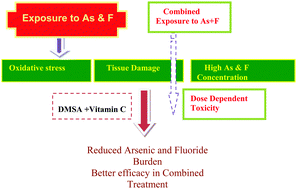Combination therapy with vitamin C and DMSA for arsenic–fluoride co-exposure in rats
Abstract
Introduction. Arsenic and fluoride are recognized globally as the most serious inorganic contaminants in drinking water. As there is no safe and effective treatment for the cases of fluoride poisoning and combined arsenic–fluoride toxicity, the present study was planned to assess (i) the mechanism of combined exposure to arsenic and fluoride via biochemical and spectroscopic data; (ii) the effect of a thiol chelating agent, meso-2,3-dimercaptosuccinic acid (DMSA), either individually or in combination with the antioxidant vitamin C in reversing arsenic–fluoride toxicity; and (iii) whether combination therapy enhances arsenic and fluoride removal from blood and soft tissues. Methods. Rats were exposed to arsenic (50 mg l−1) and fluoride (50 mg l−1) individually and in combination for 9 months and later administered DMSA (50 mg kg−1) via an i.p. route and vitamin C (25 mg kg−1) orally for 5 days. Biochemical parameters suggestive of alterations in the heme synthesis pathway, oxidative stress in blood, the liver and the kidneys, and concentrations of arsenic and fluoride in blood and soft tissues were studied. We also studied the infrared (IR) spectra of DNA extracted from the livers and kidneys of the normal and exposed animals. Results. It was found that chronic arsenic and fluoride exposure led to an increased oxidative stress condition and impaired heme synthesis (67% inhibition in δ-aminolevulinic acid dehydratase activity and 38% increase in δ-aminolevulinic acid synthetase activity). The decreased antioxidant defense mechanism was marked by a 2.25 fold increased concentration of Reactive Oxygen Species (ROS) and a 28% decrease in the Glutathione (GSH) level. Interestingly, concomitant exposure to arsenic and fluoride did not lead to antagonistic effects as the toxic effects were the same as those seen during the individual exposure to both the toxicants. It suggests that toxicity depends on the dose and duration of exposure. Combination therapy with DMSA and vitamin C showed a better efficacy than monotherapy in terms of reducing the arsenic and fluoride burden (more than 70% in blood and soft tissues) as well as reversal in the altered biochemical variables indicative of oxidative stress and tissue damage (80–85%). The infrared (IR) spectra of DNA isolated from the liver and kidneys suggested that the treatment with vitamin C and DMSA had no beneficial effects in terms of reversing DNA damage. Conclusion. On the basis of the above observations, we suggest that the combinational therapy of DMSA and vitamin C would be more effective in arsenic and/or fluoride toxicity; however, more detailed studies are required to address recoveries in DNA damage.



 Please wait while we load your content...
Please wait while we load your content...